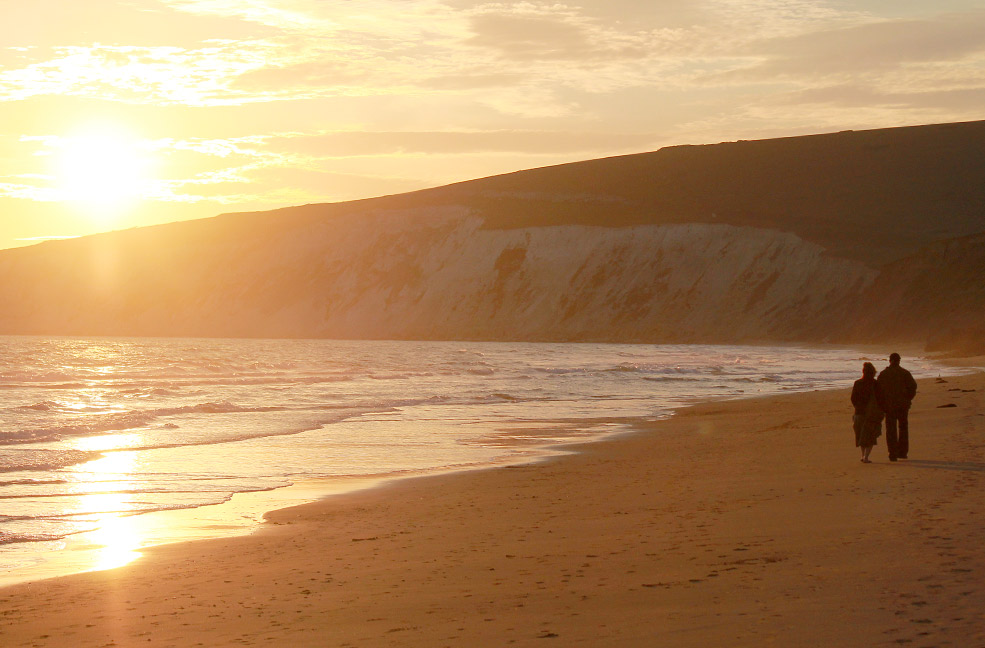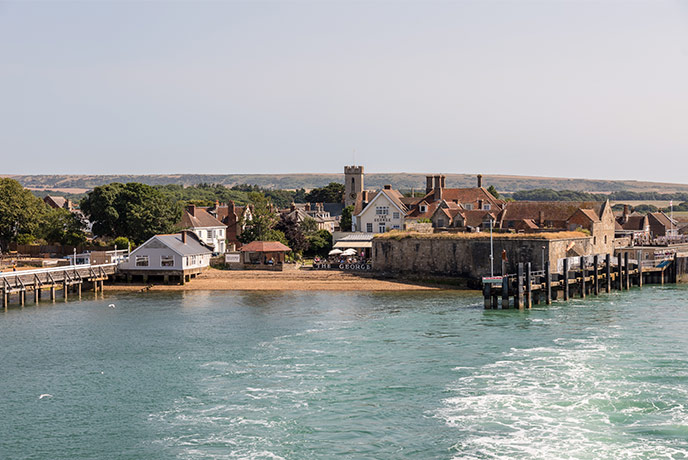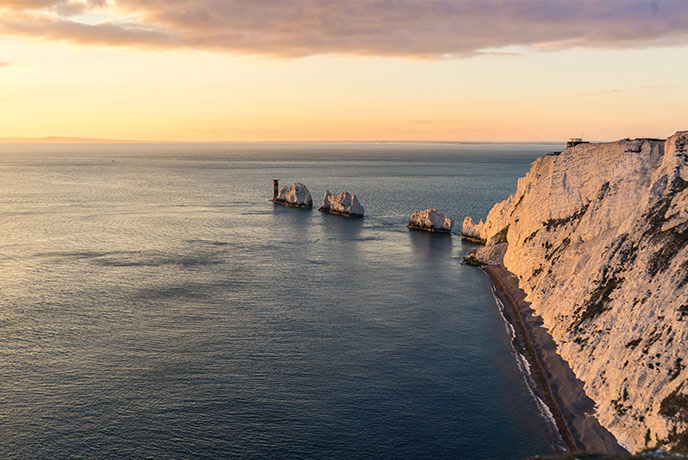The route between Freshwater Bay and The Needles is one of the finest coastal walks on the Isle of Wight. Panoramic sea views are offered throughout the journey, with the outward leg showing off views of the English Channel towards France, and the return overlooking yachts on the Solent. There is plenty of history to discover, as well as mid-way stopping points for taking in the views or enjoying a bite to eat.
The simplest circular route is 6 miles but the walk can easily be extended by exploring the Needles headland or Headon Warren. The start of the walk is hilly but the central section is mostly flat, to give you a chance to get your breath back!
Try to avoid attempting the walk on a very windy day and be prepared for minimal shade. The cliff tops are very exposed with The Needles holding the record for the highest gust ever recorded in England (125mph in 2022).
Here’s everything you need to know about this walk, including where to park, the route, and top things to do and look out for along the way!
For beautiful places to stay nearby, check out our selection of holiday homes on the Isle of Wight.
Leaving Freshwater Bay
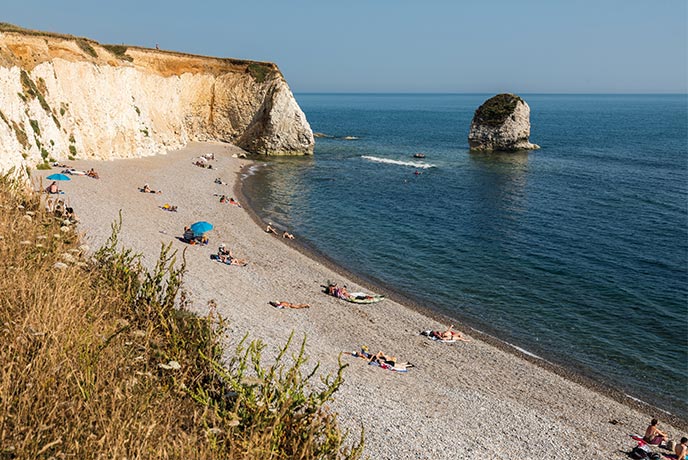
This walk begins in Freshwater Bay, a beach on the Isle of Wight that buzzes on a busy day in summer but is large enough to rarely feel crowded. Here you can expect to find paddleboarders and kayakers exploring the adjacent coves, and swimmers filling the waters that are usually calm in summer. In winter, the water is often choppy and the bay becomes a popular spot for surfers.
Wave watching is also a much-loved pastime here, with the prominent Stag Rock taking a battering during a storm. (Watch the action from home on our Freshwater Bay webcam!) It was put in place with the help of Freshwater Independent Lifeboat, which recently celebrated 50 years of saving lives in the West Wight.
Pay and display parking is available in the Isle of Wight Council car park by the beach or in The Albion Hotel’s car park. On quieter days you will also find some free spaces on Afton Road as you approach the beach from Freshwater village We recommend popping into the fabulous vegan café Freshwater Coffee House for some caffeine before you set off - fuel is always appreciated!
From the beach, follow signs for Freshwater Bay’s public toilets and you’ll find the path, which begins to ascend to the cross-shaped Tennyson Monument. You’ll pass the entrance to Fort Redoubt, a mid-19th century military base built under instruction from Lord Palmerston. The Isle of Wight’s coastline is punctuated with military buildings constructed around this time as government ministers feared French invaders would use the Isle of Wight as a stepping stone to attack the mainland.
While Fort Redoubt is not open to the public, several other similar forts can be explored on the Isle of Wight. Start with Fort Victoria in Yarmouth, Puckpool Battery in Ryde and Sandown Fort, which is now Wildheart Animal Sanctuary.
As you head up the footpath off Gate Lane and ascend the hill, take care around the herd of cows, which can often be found in the field.
Watcombe Bay to the Tennyson Monument
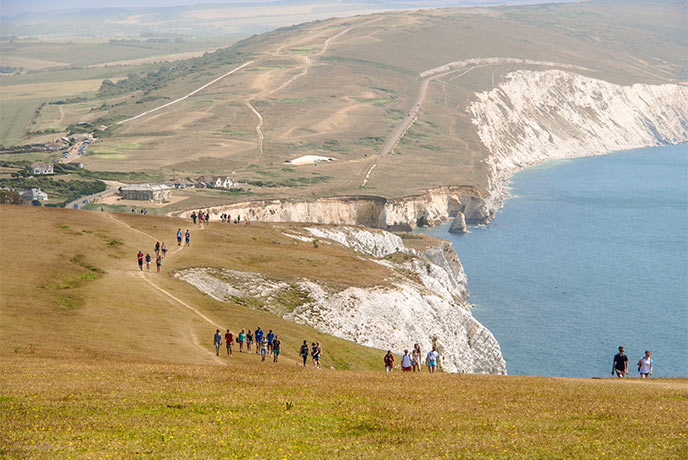
As you climb, you’ll walk above Watcombe Bay, which is one the Isle of Wight’s least accessible beaches. At one stage there was a tunnel that led from the cliff edge to the beach. This was used by smugglers who were known to land their contraband on the stony shore and hide it in the caves.
The tunnel is now blocked up so visitors have the option of either arriving by boat or climbing down with abseiling equipment. Needless to say, both options require notable expertise and carry a public health warning.
You may also see a coasteering outing being run by Freshwater Bay Coasteering. This involves reaching the Bay by climbing along the base of the cliffs with the help of lifejackets, helmets and local experts. Check out our recent coasteering adventure with Global Boarders for a taste of this fabulously fun watersport.
The climb up to the Tennyson Monument should take about 30 minutes. You will ascend to nearly 150 metres above sea level and will be grateful for the benches with a view at the peak!
This section of the walk has no fencing on the cliff edge and the drop is steep. It can also be breezy so keep a good distance from the edge.
Tennyson in Freshwater
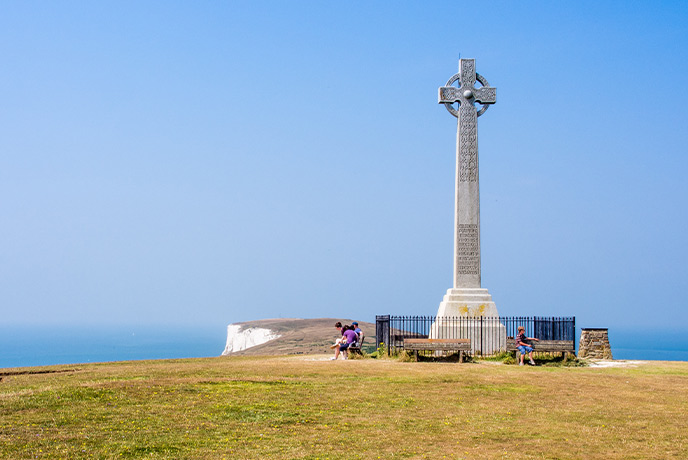
The imposing monument is a memorial to Alfred, Lord Tennyson who lived in Freshwater for around 40 years. The Poet Laureate’s home and gardens at Farringford have been restored and are open for public tours.
Tennyson regularly climbed the downs when staying at Farringford and remarked that the air was ‘worth sixpence a pint’.
His presence in Freshwater generated national interest and the West Wight became a melting pot of creative individuals. Lewis Carroll visited Tennyson (otherwise known as Charles Dodgson), as did Edward Lear, author of The Owl and The Pussycat.
Pioneering photographer Julia Margaret Cameron was another key figure in the arts scene of Freshwater Bay. She lived at Dimbola Lodge, which is now a museum and tearooms and one of the many fascinating historical houses on the Isle of Wight. Julia Margaret Cameron is credited with inventing the close-up photograph. Her portrait of Charles Darwin is a familiar image, as it featured on ten pound notes for many years.
After Tennyson’s death in 1892, locals raised money for their much-loved neighbour to have a permanent memorial.
The Tennyson Monument to The New Battery

The next section of the walk continues along the coastal path for about 35 minutes. The path undulates a little but the most challenging climb has already been conquered, which is a great feeling.
Watch out for the large burrows created by wildlife, which have chosen to set up home in this spectacular spot - who can blame them!
To your left you can enjoy views towards the English Channel. The nearest land from here is France, with Cherbourg around 70 miles away.
The first sight of The Needles comes round the back of the modern communications station but you are best to carry on to reach The New Battery.
This section of the headland hides a fascinating history of Britain’s role in the space race of the 1950s. Under great secrecy, three types of rocket were tested here by a Cowes company called Saunders Roe. They were then transported to Australia for their final launch.
By the early 1960s, there were 240 people employed at the site, many of whom worked underground. One of the surviving rockets can be seen at the British Museum while the New Battery is now looked after by the National Trust.
Follow the steps on the right just past the Coastguard tower for one of the best views of The Needles. You can also look down onto Scratchells Bay, which is only accessible by boat.
The Old Battery
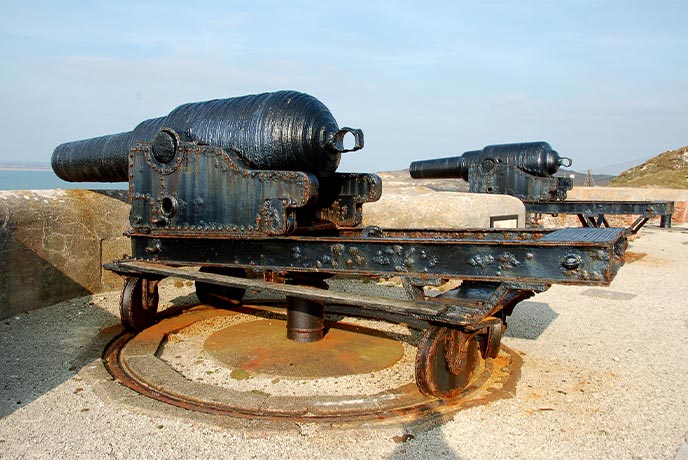
If you have time, spend an hour at The Needles Old Battery, which is reached by walking down some steps near to the Coastguard station.
Entrance is free for National Trust members and the tea rooms are an excellent spot to celebrate the midway point of your walk with some refreshments.
The site is small but it’s rich in history and is a great photo opportunity. The battery was another of Prime Minister Palmerston’s military buildings, which was constructed in the 1860s, fearing a French invasion.
The huge guns at the Old Battery have their own story to tell. They were decommissioned and pushed off the cliff in 1903. Eighty years later, the National Trust had taken control of the site and successfully winched the guns back to their original homes.
A highlight of the visit is a narrow tunnel that leads to a windswept lookout, nestled within the rocks. It’s easy to imagine a night shift as a Victorian soldier stood at the searchlight emplacement overlooking the Needles.
The Needles
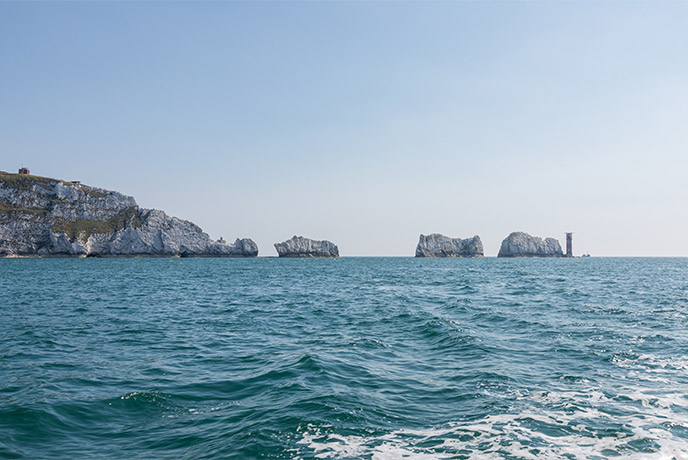
The three chalk stacks and Needles lighthouse are perhaps the Isle of Wight’s most famous landmark. They get their name from a thin pillar known as Lot’s Wife, which once stood amongst the stacks. It disappeared during a storm in the 18th century.
Many ships have been wrecked at The Needles, including HMS Pomone, which crashed in 1811. A dramatic rescue saw all 283 people brought safely to shore. It remains a popular spot for divers and underwater archaeologists.
The current lighthouse has certainly saved many lives over the years. It was built in 1859 and had a keeper living on-site right up until 1994.
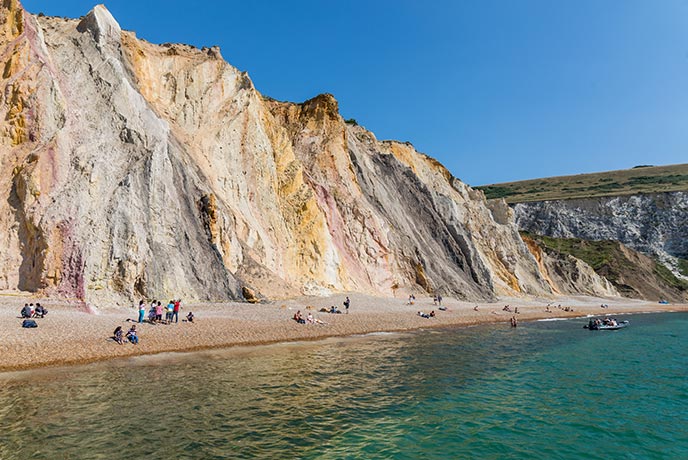
The nearby beach at Alum Bay is a busy spot that offers funfair rides, a large café, glass blowing, sand filling, boat trips and the famous chairlift. Our walk misses out this attraction but you may like to explore and make a day of it.
If you take this detour, walk along the road that connects the Old Battery to The Needles car park. The road is exclusively for buses and it gives an excellent view of the famous multicoloured sands of Alum Bay. There are said to be 21 different shades of sand in the cliffs, which were shaped over millions of years.
This stretch of road will also be familiar to viewers of the TV series The Beast Must Die. It was here that the central plot point took place. We will avoid spoilers!
Looking towards the Solent

If you are following the 6-mile route then you’ll find the footpath on the zigzag road that links the Needles New Battery with the Old Battery. Both are signposted as ‘Coastal Path’ and follow a route in front of a row of cottages, which were once coastguard accommodation.
Take the higher route, which follows a parallel path to the one which took you to The Needles. This side of the Downs gives a different perspective with a panoramic vista of the Solent. To the west is Mudeford, Bournemouth and the Dorset coast. To the east is the West Wight town of Yarmouth and Fort Albert (another of Palmerston’s coastal defences).
Hurst Castle is particularly prominent, as the closest mainland point to the Isle of Wight. The gap is just over a mile, which makes it the chosen spot for organised challenges to swim across the Solent.
The Castle was built by Henry VIII and once held Charles I prisoner. The narrow gap across the water also made it a useful point for defending the Solent in the 19th and 20th centuries.
If you are carrying binoculars you may be able to see where nature’s power has taken its toll on Hurst Castle. In 2021, a large section of the east wing collapsed. English Heritage has laid 22,000 tonnes of rock and shingle to provide a coastal defence so that repairs can take place.
Back towards Freshwater
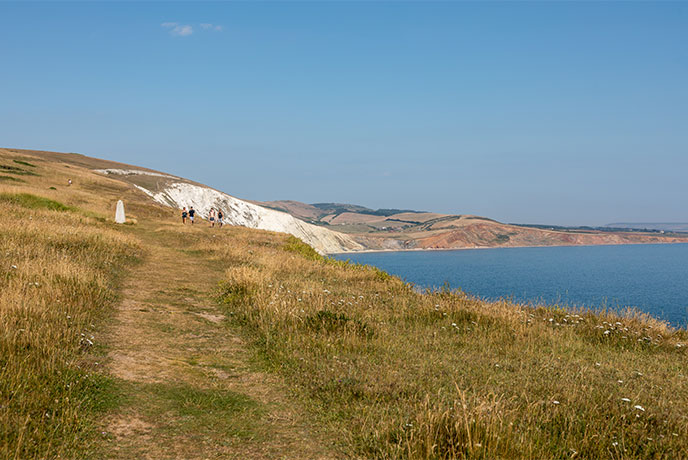
After about 1.5 miles along this footpath you will reach a signpost that offers routes towards Freshwater (T24) or the Tennyson Monument (T25). Take the Tennyson Monument route and climb back up the hill towards the high point. Some walkers prefer the variety of the path into Freshwater but the views are better on the T25 route.
Nearby, you will see a half size replica beacon that was placed in 1977 to celebrate the Queen’s Jubilee. The original beacon stood in place of the Tennyson Monument and helped sailors to navigate along the coastline. This tradition was recreated in 2022 when a temporary beacon was lit on Tennyson Down for the Queen’s Platinum Jubilee.
As you descend into Freshwater Bay, there are several converging footpaths. Head towards the right hand side for the best views of the coastline towards Compton Bay, Brook Chine and Blackgang Chine.
From here, you can see the two rocks that stand prominently within Freshwater Bay. The closer rock is known as the Stag Rock, which is thought to have gained its name when a stag attempted to escape a hunt by leaping from the cliff and onto the rock. As you will see up close, it is some distance!
The other remaining rock is known as Mermaid Rock. In 2020, a notable chunk of this landmark collapsed during a storm, giving it a completely different look.
There was once a third rock, which was an elegant arch that stood between the Stag and the Mermaid. This fell in October 1992, leaving a base that is just about visible at low tide.
As you return to Freshwater Bay, stop for a drink at either The Piano Café (once owned by Queen Victoria’s piano tuner and now one of the best places to eat on the Isle of Wight) or Dimbola Lodge. You’ve earned it!
Explore our beautiful holiday cottages on the Isle of Wight to find the perfect base for your coastal walks and historical explorations. There is so much to discover on this captivating island.


